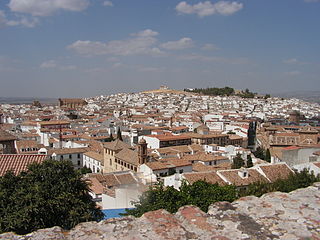Nestled in the heart of Andalusia, Spain, Antequera is a city rich with history and culture, often referred to as the “heart of Andalusia” due to its central location among Malaga, Granada, Cordoba, and Seville. This city offers an impressive architectural heritage, including more than fifty monuments and churches, such as the Alcazaba and the Royal Collegiate of Santa María. The surrounding landscape is just as breathtaking, with the natural wonder of El Torcal Park and the remarkable dolmens, which are UNESCO World Heritage Sites. Antequera is a captivating blend of historical legacy and natural beauty, ideal for those seeking to immerse themselves in authentic Spanish culture.
Prepare to walk through history by wearing comfortable shoes as you explore Antequera’s cobbled streets, ancient structures, and natural reserves.
To fully appreciate the city’s charm, plan your visit during the spring or autumn months when the weather is most pleasant.
Top things to do & see in Antequera
Select the following sights and activities to discover best tickets and tours available in Antequera.
Antequera: The Heart of Andalucía
| Country | Spain |
| Time in Antequera | GMT+1 |
| Language spoken | Spanish |
| Population | 41,854 (Data Source: National Institute of Statistics, Spain, 2022) |
| Currency | Euro (€, EUR) |
| Airports |
|
Antequera, a breathtaking city nestled in the province of Málaga, Spain, is a resplendent blend of history, culture, and natural beauty. Famously recognized for its Bronze Age and Roman monuments, Antequera has been a significant crossroad through various civilizations over the millennia. The city, wholly immersed in the rich tapestry of Andalucian culture, is home to over fifty historic churches, a testament to its deep-rooted religious history. Antequera also prides itself on the Dolmens of Menga, Viera, and El Romeral, collectively a UNESCO World Heritage site, offering a glimpse into ancient megalithic culture.
Where is Antequera?
Antequera is located at a strategic crossroads in the heart of Spain’s Andalucía region, surrounded by the fertile plains of the Guadalhorce valley.
Distances:
| Route | Distance by car | Time by car |
|---|---|---|
| Málaga to Antequera | 35 miles (56 km) | About 50 minutes |
| Granada to Antequera | 65 miles (105 km) | About 1 hour 15 minutes |
| Seville to Antequera | 99 miles (159 km) | About 1 hour 45 minutes |
What is Antequera famous for?
Antequera is revered for its rich historical legacy, featuring some of Spain’s most significant dolmens and an array of beautiful Baroque architecture. It captivates visitors with a compelling blend of cultural heritage and natural wonders like the striking El Torcal park.
History
Prehistoric to Roman Antequera: c. 5000 BCE – 4th century CE
From the Neolithic through the Bronze Age, the region of Antequera was a significant cultural hub. The numerous dolmens, including the Menga and Viera, serve as evidence of these ancient communities. By the first millennium BCE, the Iberians had settled the area, which later attracted the Phoenicians and subsequently fell under Roman rule, becoming known as “Antikaria”.
Visigothic to Moorish Rule: 5th – 15th century
After the collapse of the Roman Empire, the Visigoths controlled Antequera until the Umayyad conquest in the early 8th century introduced Islamic rule. The town, now known as “Medina Antaquira,” flourished under Muslim governance, known for its fortifications and strategic importance in Andalusia.
Christian Reconquest and Renaissance: 15th – 17th century
In 1410, Antequera was reconquered by the Christians, marking a significant shift. The 16th century saw a cultural and architectural renaissance in Antequera, with the construction of numerous churches, convents, and palatial homes in the distinctive Spanish Renaissance style.
Modern Era: 18th century – Present
The 18th and 19th centuries brought industrial growth to Antequera, particularly in agriculture and textile manufacturing. In contemporary times, the city has embraced its rich history and cultural heritage, establishing itself as a tourist destination known for its well-preserved historical sites and natural scenery.
Visit Antequera
What to see and do in Antequera
Antequera boasts a rich tapestry of cultural and natural attractions. Key landmarks include the Alcazaba, a well-preserved Moorish fortress offering panoramic views of the city, and the adjacent Royal Colegiata de Santa María la Mayor.
The city’s fascinating history can be further explored in the Municipal Museum of Antequera. For nature lovers, the nearby El Torcal Natural Park presents an extraordinary landscape of limestone rock formations, ideal for hiking and wildlife viewing.
- Explore the Alcazaba and Royal Colegiata
- Visit the Municipal Museum
- Hike in El Torcal Natural Park
Notable annual events in Antequera
Antequera’s calendar is filled with vibrant festivals and events. The most notable include the May Crosses Festival in early May, where elaborately decorated crosses are displayed throughout the town. The Antequera Blues Festival fills the air with music each July, and during Holy Week, the streets come alive with processions and religious fervor.
Best time to visit Antequera
The ideal time to visit Antequera is during the spring (April to June) or the early autumn (September to October), when the weather is mild and conducive to exploring both the city’s historic sites and natural surroundings.
Is Antequera worth visiting?
Antequera is unquestionably worth visiting for its rich blend of historical, cultural, and natural treasures. The city offers a unique glimpse into Andalusia’s past and present, making it a compelling destination for both history buffs and nature enthusiasts alike. The well-preserved architectural sites combined with the stunning natural beauty of El Torcal makes Antequera a hidden gem in the heart of Andalusia.










